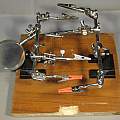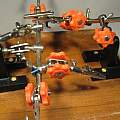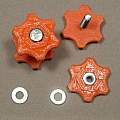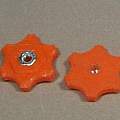Customised Third/Helping hand
Being involved in hobby electronics in the early 1970s I saw adverts for helping (aka third) hands appear. I didn't buy one then. I don't know if that is when they were invented or by whom. They're popular now, exactly the same design, although no longer made in England.
For holding things whilst I soldered I would put a rubber band around a pair of pliers.
Recently I bought a collection of these devices to hold stuff whilst I photographed it. Having them, I used them for electronics.
Customisation is unavoidable, the magnifying glass is not much use, so most of them go, and the metal base is scratchy so one sticks on rubber feet.
I saw expensive versions, with multiple 'hands' attached to a base. For example see:
Third Hand on Soldering Board - Cousins
this company also have the useful third hand with a pair of self locking tweezers - something which is easy to emulate.
Then I watched a video:
Make a Super-Bright 10 Watt LED Task Lamp w/ Third Hand Soldering Holder
in which someone skilled makes their own helping hand and the penny dropped. All I had to do is fix a couple of them to a heavy piece of wood. Big improvement, they won't fall over, no messing using the magnifier as a counterweight. With two on the same board it is possible to use them to hold more than one object and they will keep their relative position.
The bases of the helping hands I have are made of cast iron - it is easy to drill.
More customisation, three clips on each side. It seems common to add soft (perhaps heat shrink) tubing to the clips to make them less harsh. The pivoting/clamping mechanisms are difficult to tighten by hand and I'd replace those if I could find suitable bolts and knobs.
In 50 years most of the significant change in commercial versions has been to add a soldering iron stand. Turning something which is unstable into something which is very unstable and dangerously hot. Perhaps an example of making a product which looks like a good idea.
A new direction is to use flexible connectors (Loc-Line-style modular hose):
Third Hand++ - Instructibles
Flexible screwdriver extension shafts would also work for this.
Many people with 3D printers have done better versions:
Ultimate Helping Hand Jig - Thingiverse
I printed some thumbscrews:
Thumb Knob - 25 5 M4 nut
the helping hands I have use M4 threads. The thumbscrews take an M4 hex head bolt or M4 hex nut, it is important to have a couple of washers to allow the thumb knobs to tighten without seizing. This is not a great use of 3D printing or engineering on my part but it is another improvement.
The thumb knob is a customised version of
Customizable Thumb Knob - Metric - by Harrison
which is a good piece of work, all credit to the author.
Someone else's effort:
Building a stable third hand (with pouring of Lead) - Andreas Spiess
I read in the comments of Blu Tack vs Helping Hands user "InTnMnNmAz" suggest Belleville springs, aka push nuts, aka spring washers, aka starlock washers.
There is a page on Wikipedia - Helping hand (tool), however I can find no corroborating information, as they say "citation needed".
David Pilling's Wiki
Set view



